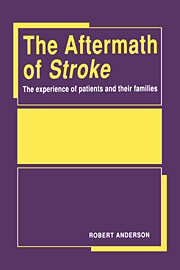Book contents
- Frontmatter
- Contents
- Acknowledgements
- Chapter 1 Stroke: An introduction to the problem
- Chapter 2 The Greenwich stroke study
- Chapter 3 Coming into medical care: the first month after stroke
- Chapter 4 Hospital care and rehabilitation
- Chapter 5 Survival, physical disability and health
- Chapter 6 Support in the community
- Chapter 7 The effects of stroke on social, family and personal life
- Chapter 8 Caring and coping with stroke
- Chapter 9 Resources for coping with stroke
- Appendix: Measurement and scoring of variables
- References
- Index
Chapter 1 - Stroke: An introduction to the problem
Published online by Cambridge University Press: 07 October 2011
- Frontmatter
- Contents
- Acknowledgements
- Chapter 1 Stroke: An introduction to the problem
- Chapter 2 The Greenwich stroke study
- Chapter 3 Coming into medical care: the first month after stroke
- Chapter 4 Hospital care and rehabilitation
- Chapter 5 Survival, physical disability and health
- Chapter 6 Support in the community
- Chapter 7 The effects of stroke on social, family and personal life
- Chapter 8 Caring and coping with stroke
- Chapter 9 Resources for coping with stroke
- Appendix: Measurement and scoring of variables
- References
- Index
Summary
Every year, in a typical Western population of 100 000 people, about 200 suffer a stroke and come into medical care. Most of these people are admitted to hospital but the proportion varies, depending, in part, upon whether the patient lives in town or country. Stroke is the most important single cause of hospital use after mental disorders; altogether, care of stroke patients may absorb about 6% of hospital running costs and nearly 5% of all National Health Service costs (Carstairs, 1976). As a report from the Royal College of Physicians (1990) underlines, stroke is a major cause of chronic disability and the source of a heavy burden on patients' relatives and friends, as well as consuming a great deal of the resources of the health and welfare services.
About a quarter of the people who suffer a stroke die in the first month, but more than half survive for a year or more (Aho et al., 1980; Warlow et al., 1987). Most stroke survivors, probably about two-thirds, are rated as independent in daily activities by 1 year after the stroke (Weddell and Beresford, 1979; Wade et al., 1985b; Warlow et al., 1987), although this does not mean that they have returned to levels of activity or performance that they had before the stroke. Altogether, in a population of 100 000 people there are roughly 750 survivors of stroke, most of them living in the community with, or near to, family, and with varying levels of disability (Warlow et al., 1987).
- Type
- Chapter
- Information
- The Aftermath of StrokeThe Experience of Patients and their Families, pp. 1 - 12Publisher: Cambridge University PressPrint publication year: 1992



